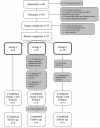Pilot study of the effectiveness of a telehealth group for improving peer relationships for adolescents with neurofibromatosis type 1
- PMID: 38475852
- PMCID: PMC10935956
- DOI: 10.1186/s13023-024-03093-1
Pilot study of the effectiveness of a telehealth group for improving peer relationships for adolescents with neurofibromatosis type 1
Abstract
Background: Interventions for social difficulties have not been investigated in the neurofibromatosis type 1 (NF1) population despite observations of elevated rates of social difficulties. In this pilot study, the effectiveness of a 14-week telehealth PEERS® intervention with nineteen adolescents with NF1 (Mage=13.79 years, SD = 1.32) with social skills difficulties was examined. Measures of social outcomes were completed at three timepoints (before, immediately after, and at 14-week follow-up).
Results: Caregiver-reported social-emotional skills, social impairment, caregiver-reported number of adolescent get-togethers, and teen social knowledge showed significant improvement following the intervention.
Conclusions: The PEERS® intervention is promising to support the social and friendship skills of adolescents with NF1 who have social difficulties.
Keywords: NF1; Neurofibromatosis type 1; PEERS®; Social; Telehealth; Virtual.
© 2024. The Author(s).
Conflict of interest statement
The authors declare that they have no competing interests.
Figures
Similar articles
-
Feasibility and acceptability of a telehealth intervention for improving peer relationships for adolescents with neurofibromatosis type 1: a single-arm pilot study.J Pediatr Psychol. 2024 Sep 1;49(9):647-655. doi: 10.1093/jpepsy/jsae050. J Pediatr Psychol. 2024. PMID: 38908005
-
Efficacy of PEERS® for Adolescents via Telehealth Delivery.J Autism Dev Disord. 2022 Dec;52(12):5232-5242. doi: 10.1007/s10803-022-05580-5. Epub 2022 May 27. J Autism Dev Disord. 2022. PMID: 35624224 Free PMC article.
-
Brief Report: A Pilot Study Examining the Effects of PEERS® for Adolescents Telehealth for Autistic Adolescents.J Autism Dev Disord. 2022 Dec;52(12):5491-5499. doi: 10.1007/s10803-022-05666-0. Epub 2022 Jul 23. J Autism Dev Disord. 2022. PMID: 35870099 Free PMC article.
-
Improving Social Knowledge and Skills among Adolescents with Autism: Systematic Review and Meta-Analysis of UCLA PEERS® for Adolescents.J Autism Dev Disord. 2021 Dec;51(12):4488-4503. doi: 10.1007/s10803-021-04885-1. Epub 2021 Jan 29. J Autism Dev Disord. 2021. PMID: 33512626
-
Psychosocial Features of Neurofibromatosis Type 1 in Children and Adolescents.J Child Neurol. 2018 Mar;33(3):225-232. doi: 10.1177/0883073817749367. Epub 2018 Jan 10. J Child Neurol. 2018. PMID: 29318935 Review.
References
-
- Huijbregts SC, Loitfelder M, Rombouts SA, Swaab H, Verbist BM, Arkink EB, et al. Cerebral volumetric abnormalities in neurofibromatosis type 1: associations with parent ratings of social and attention problems, executive dysfunction, and autistic mannerisms. J Neurodev Disord. 2015;7(1):32. doi: 10.1186/s11689-015-9128-3. - DOI - PMC - PubMed
MeSH terms
Grants and funding
LinkOut - more resources
Full Text Sources
Medical
Research Materials
Miscellaneous


